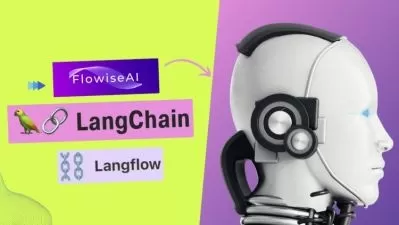Mathematics Behind Large Language Models and Transformers
Patrik Szepesi
4:42:14
Description
Deep Dive into Transformer Mathematics: From Tokenization to Multi-Head Attention to Masked Language Modeling & Beyond
What You'll Learn?
- Mathematics Behind Large Language Models
- Positional Encodings
- Multi Head Attention
- Query, Value and Key Matrix
- Attention Masks
- Masked Language Modeling
- Dot Products and Vector Alignments
- Nature of Sine and Cosine functions in Positional Encodings
- How models like ChatGPT work under the hood
- Bidirectional Models
- Context aware word representations
- Word Embeddings
- How dot products work
- Matrix multiplication
- Programatically Create tokens
Who is this for?
What You Need to Know?
More details
DescriptionWelcome to the Mathematics of Transformers, an in-depth course crafted for those eager to understand the mathematical foundations of large language models like GPT, BERT, and beyond. This course delves into the complex mathematical algorithms that allow these sophisticated models to process, understand, and generate human-like text. Starting with tokenization, students will learn how raw text is converted into a format understandable by models through techniques such as the WordPiece algorithm. We’ll explore the core components of transformer architectures—key matrices, query matrices, and value matrices—and their roles in encoding information. A significant focus will be on the mechanics of the attention mechanism, including detailed studies of multi-head attention and attention masks. These concepts are pivotal in enabling models to focus on relevant parts of the input data, enhancing their ability to understand context and nuance. We will also cover positional encodings, essential for maintaining the sequence of words in inputs, utilizing cosine and sine functions to embed the position information mathematically. Additionally, the course will include comprehensive insights into bidirectional and masked language models, vectors, dot products, and multi-dimensional word embeddings, crucial for creating dense representations of words. By the end of this course, participants will not only master the theoretical underpinnings of transformers but also gain practical insights into their functionality and application. This knowledge will prepare you to innovate and excel in the field of machine learning, placing you among the top echelons of AI engineers and researchers
Who this course is for:
- For ambitious learners aiming to reach the upper echelon of the programming world: This content is designed for those who aspire to be within the top 1% of data scientists and machine learning engineers. It is particularly geared towards individuals who are keen to gain a deep understanding of transformers, the advanced technology behind large language models. This course will equip you with the foundational knowledge and technical skills required to excel in the development and implementation of cutting-edge AI applications
Welcome to the Mathematics of Transformers, an in-depth course crafted for those eager to understand the mathematical foundations of large language models like GPT, BERT, and beyond. This course delves into the complex mathematical algorithms that allow these sophisticated models to process, understand, and generate human-like text. Starting with tokenization, students will learn how raw text is converted into a format understandable by models through techniques such as the WordPiece algorithm. We’ll explore the core components of transformer architectures—key matrices, query matrices, and value matrices—and their roles in encoding information. A significant focus will be on the mechanics of the attention mechanism, including detailed studies of multi-head attention and attention masks. These concepts are pivotal in enabling models to focus on relevant parts of the input data, enhancing their ability to understand context and nuance. We will also cover positional encodings, essential for maintaining the sequence of words in inputs, utilizing cosine and sine functions to embed the position information mathematically. Additionally, the course will include comprehensive insights into bidirectional and masked language models, vectors, dot products, and multi-dimensional word embeddings, crucial for creating dense representations of words. By the end of this course, participants will not only master the theoretical underpinnings of transformers but also gain practical insights into their functionality and application. This knowledge will prepare you to innovate and excel in the field of machine learning, placing you among the top echelons of AI engineers and researchers
Who this course is for:
- For ambitious learners aiming to reach the upper echelon of the programming world: This content is designed for those who aspire to be within the top 1% of data scientists and machine learning engineers. It is particularly geared towards individuals who are keen to gain a deep understanding of transformers, the advanced technology behind large language models. This course will equip you with the foundational knowledge and technical skills required to excel in the development and implementation of cutting-edge AI applications
User Reviews
Rating
Patrik Szepesi
Instructor's Courses
Udemy
View courses Udemy- language english
- Training sessions 29
- duration 4:42:14
- Release Date 2024/08/11











